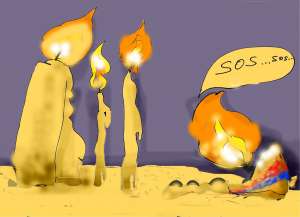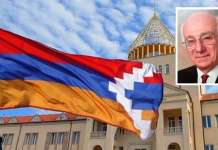 In recent years, sexual scandals plaguing the Catholic Church in the US and elsewhere have become routine. These scandals dominate the headlines and have weakened the Catholic Church, which besides being a religious institution, is also a powerful political force. For instance, it was revealed recently that Pope Francis had played a major role in the US-Cuba rapprochement.
In recent years, sexual scandals plaguing the Catholic Church in the US and elsewhere have become routine. These scandals dominate the headlines and have weakened the Catholic Church, which besides being a religious institution, is also a powerful political force. For instance, it was revealed recently that Pope Francis had played a major role in the US-Cuba rapprochement.
When there is such a powerful institution with awesome political clout, there certainly will be other forces offended or hurt by that clout and they will resort to any means at their disposal — in this case, the news media — to retaliate.
Having said that, the Catholic priests caught red-handed cannot be absolved as the courts have been handing down guilty verdicts in many cases, resulting in embarrassment and huge damages for the church and its coffers.
The issue of clergy celibacy is considered the root cause of those abuses while the Catholic Church obstinately remains attached to that anachronistic practice. The Catholic Church has gone through many reforms, and has still more to face, yet the issue of clergy celibacy is not on the agenda.
As we review the media coverage, more often than not, the Catholic Church seems to be singled out for exposure. Other denominations certainly experience similar problems, but we learn about them only casually or seldom.
When you don’t have tangible facts at hand, you are on a very dangerous road to prove a conspiracy theory. But when you extrapolate the facts you may state with a certain confidence that there must be validity to such a conspiracy in operation and their motivation is a power struggle.
Warring factions always count on the weaknesses of the opponent to exploit and to score points or victory. And the Catholic Church — or its sinning clergy — has been exposing those weaknesses.
The above introduction was presented in order to outline the parameters of this multidimensional problem.
Now it seems that the scandal has come to knock on the doors of the Armenian Church. News has been circulating in Israeli and Armenian news outlets as well as social media about sexual abuse by Armenian clergy.
The scandal has many components. Armenians being part of the human race, they are also preconditioned to be afflicted by the vices of the rest of the humans. An element of primitive pride sometimes keeps us in the mode of self-denial. We think that there cannot be drug addiction among Armenians, nor domestic violence, nor prostitution, etc. In reality, all of the above are part and parcel of our social fabric. The issue remains how to identify them, find the root causes and face them realistically and how we we treat them or deal with them prudently.
During the last week in February, an Israeli TV channel called Israel Today aired a 15-minute documentary titled “Demons of the Past,” where an accuser, named Hrayr Yezegelian, is featured entering the Armenian Monastery of St. James in Jerusalem to face Fr. Khat Jundurian, who allegedly had abused him sexually at age 13 when he was a seminary student.
Viewing the video clip circulating on Facebook, it seems it is carefully choreographed and staged.
The same alleged victim, Mr. Yezegelian, 38, also accused Archbishop David Sahakian, who was the dean of Jerusalem Seminary in 1990. According to the Le Progres newspaper, a lawsuit was filed against the archbishop on July 22, 2013, and on January 22, 2015, the French law enforcement agencies launched an investigation. He was charged with sexual abuse of a child under 15. The archbishop passed away in the middle of March in Decienes (Rhone), France at the age of 81. He had been serving the Diocese of Lyon in France.
According to a knowledgeable writer, Nahabed Melkonian, who has released an article on the Internet (“When Pandora’s Box Has Been Opened”), another priest from the St. James Brotherhood, Fr. Norayr Kazazian, visited Fr. Khat in Bethlehem, asking him to admit misconduct and apologize to Hrayr Yezegelian. During three consecutive visits, he secretly recorded “the confessions” of Fr. Khat, probably to be used by the producer of the program on TV.
The interesting item to note is that the alleged victim has confessed on Facebook: “This individual has found the perfect prey in me and abused me for years also, even long after leaving the seminary school.”
This raises the question of why he would return to the seminary after leaving if he were offended by the conduct of his abuser.
In the aftermath of the airing of this documentary by the TV station, an attorney, Roni Aloni-Sdovnik, has filed a lawsuit against the Patriarchate, seeking 15 million Israeli shekels in damages.
Officially, the Patriarchate has been silent so far.
The incident has several dimensions: a)The veracity of the accusation which in turn touches on b) the issue of celibacy and c) what the Israeli station gains by airing the incident, at the same time implicating the Patriarchate as an institution, beyond the alleged individual culprit.
A background check reveals that after the Israeli army’s occupation of Beirut, Lebanon, in 1982, the Yezegelian family moved to Jerusalem, where the Patriarchate provided them with housing, according to its long-held tradition. The three brothers have been enrolled at the seminary, but they have chosen not to enter into the priesthood. Hrayr, at the age of 38, seems to be a lifelong student, studying psychology. He seems to be a drifter, in need of some psychological help.
In the meantime, he decided to join the Mormon Church. For many years, the alleged sexual abuse did not bother him enough for him to take action. Only after the expiration of the statute of limitation did he come out to accuse his alleged abusers. In a dubious collaboration, Fr. Norayr Kazazian has secretly videotaped Fr. Khat Jundurian’s confession. He also invited the Israeli TV to shoot the confrontation of the “victim” and the “abuser” while interfering during a church service.
We cannot absolve the predators and we can only sympathize with the “victim” if indeed the accusation has a foundation. But the theatrical denouement of the situation smells fishy. The people and the TV channel have gone too far and their actions do not pass the smell test. If Hrayr was indeed a victim, he is being victimized again along with the institution of the Patriarchate, which faces public embarrassment, beyond the 15 million shekel lawsuit.
The TV channel Israel Today has yet to dedicate a documentary to Yeshiva students who spit at the faces of the Armenian clergy and desecrate the walls of the churches, which the police and the courts ignore.
Another suitable topic for the same TV channel to investigate might be the causes for the dwindling Armenian community in Jerusalem. Indeed, in 1967 the Armenian Community in Jerusalem was 10,000 to 15,000 strong. Today, the count is below 1,500.
Even if Hrayr Yezegelian’s accusation have no foundation, we cannot rule out abuses in a monastic setting, where male celibate priests live together.
Until the fifth century, Armenian catholicoi and archbishops were married and raised families. Gradually, celibacy made inroads in the church, with ascetic monks sacrificing worldly pleasures and taking a vow of celibacy. There were even stylites, ascetic monks who drove the self-punishment to the extreme by living on top of pillars for many years on. The self-flagellation of celibate priests is well-described poetically in Gregory of Narek’s Book of Lamentations.
The celibate priests practiced monastic life in isolation. The monasteries were called anabat (wilderness or desert).
Archbishop Malachia Ormanian states in his book, The Armenian Church, that the celibate priests could not assume pastoral positions nor perform sacraments of marriage and funerals, because they were not supposed to come into contact with parishioners or the public.
In today’s globalized world, these canons have outlived their usefulness. The celibate priests no longer observe the rigors of monastic life; they are out in public. The temptation is overpowering and that is why we come across clergy promiscuity and sexual abuse. One of the priorities in reforming the Armenian Church must be the abolition of celibacy, which is seldom truly practiced anyway. The elimination of celibacy is not a cure all but it will certainly reduce the number of incidences and some will be honest with themselves and relieve the church of hypocrisy. After all, it is not celibacy that creates child abuse, but since people who can find a life in a pseudo-celibate life can often be around children, it is an ideal situation for them to find victims.
Armenians occupy one fourth of the old city of Jerusalem — a disproportionate figure compared to the size of the population. In addition to many churches and monasteries, the Patriarchate also owns prime real estate there.
The St. James Brotherhood in Jerusalem has historically been a source of pride and embarrassment. For centuries it has trained clergy for Armenian Churches around the world. Many scholarly volumes have been produced there. And, Jerusalem’s Patriarchate houses the largest collection of illuminated manuscripts after the Matenadaran in Yerevan. But it has also rocked the Armenian world with sporadic scandals, with valuable real estate “lost” from time to time, manuscripts and chalices disappear, and sexual abuse and promiscuity are reported from time to time. Sometimes, some priests are worthy of blame in those cases. But the Patriarchate’s possessions are prime reasons for encroachment by others.
Many discredited methods are implemented by other religious orders and the Israeli government to bilk chunks of Armenian properties.
During the Camp David summit in July 22-25-2000, Ehud Barak of Israel and PLO leader Yasser Arafat had almost signed a peace agreement, under President Clinton’s prodding. But the deal fell through because of some sticking points. Along with a number of critical matters, Israel insisted on keeping the Armenian Quarter under its rule, which Arafat refused.
That historic fact can attest to the importance of the Armenian Quarter for the Israeli government.
There are a number of properties lost or leased for 100 or 200 years. There may also be others which remain unreported.
The holy places are governed by a set of regulations enshrined in what is called the Status Quo. Those regulations had been established through a firman (decree) issued by the Ottoman Sultan Osman III in the 18th century. After the Ottomans, British colonial rule and the Jordanian administration have observed it carefully, the Israeli authorities are officially committed to it, but in the case of the Armenians, the regulations are being undermined at a steady process.
The St. James Brotherhood is technically independent from outside interference. Even the supreme authority of the Armenian Church legally has no say. That is why some clergy out there demonstrate their arrogance with impunity.
As the brotherhood weakens, opportunities are offered for intruders. If today Fr. Norayr Kazezian serves as a conduit to exposed so-called scandal, we may rest assured that other elements are being tested continually because the prize is so valuable.
In addition to the illuminated manuscripts there are other archival materials vital for Armenian history. For example, during World War I, the archives of the Constantinople Patriarchate were moved to Jerusalem for safekeeping. They contain crucial documents about the Armenian Genocide. No one for sure is aware of their fate.
St. James Brotherhood always prided itself with many scholarly works. The last Mohican was perhaps Archbishop Norayr Bogharian, the guardian and the cataloguer of the manuscripts. After his death, no catalogs have been published to our knowledge.
The sexual abuse scandal seems to be the tip of the iceberg. The TV exposure and the invasion of the Patriarchate do not auger well.
Indeed, the “Demons of the Past” have been resurrected but their target seems to be somewhere beyond the predators — it is the destiny of the Armenian Patriarchate in Jerusalem.















